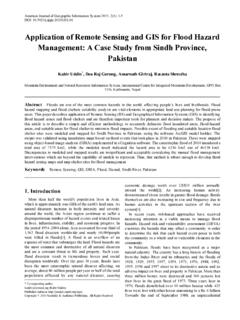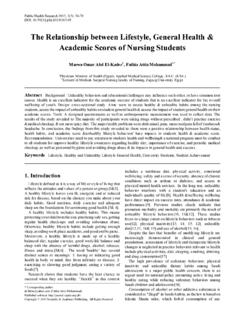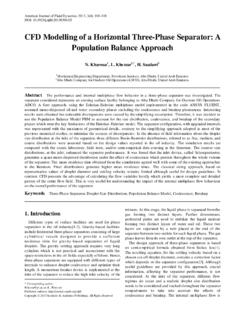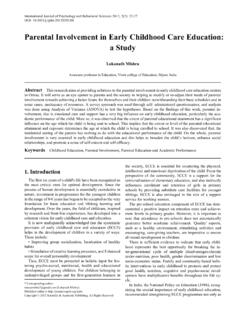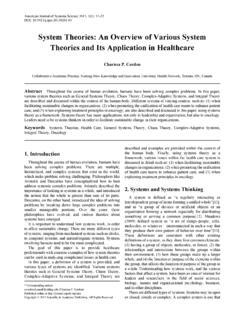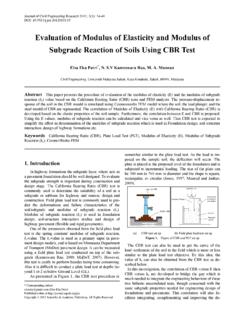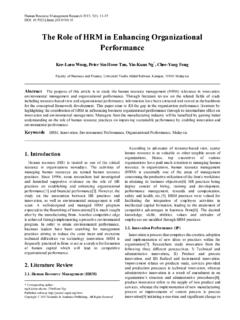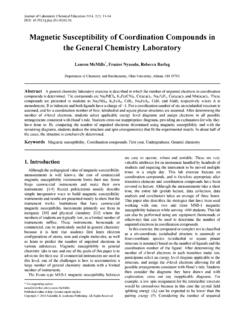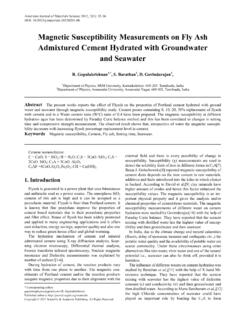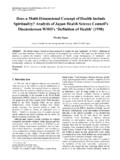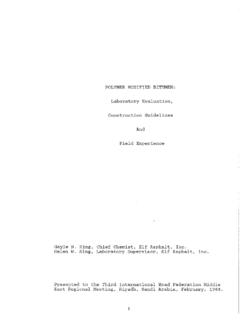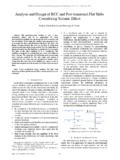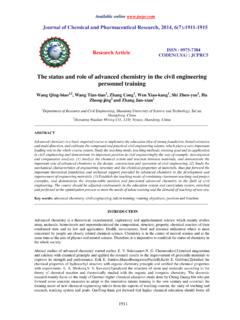Transcription of Microstructural Evolution and Mechanical Properties of ...
1 International Journal of M etallurgical En gineer in g 2013, 2(2): 149-153 DOI: Microstructural Evolution and Mechanical Properties of Type 304 L Stainless Steel Processed in Semi-Solid State Dipti Samantaray1,*, Vinod Kumar2, A. K. B haduri1, Pradip Dutta3 1M at erials Develop ment and Technolo gy Group , IGCAR, Kalp akkam, 603102, India 2 Steel Products Group , R&D Centre for Iron & Steel, SAIL, Ranch i, 834002, India 3 Dep artment of M echanical En gin eerin g, Ind ian Institute of Science, Ban galore, 560012, India Abs t rac t The paper discusses the effect of se mi-solid processing on the Microstructural Evolution and Mechanical property of 304L stainless steel. For the study, steel specimens were partially melted and cooled to room temperatures in different cooling mediu m.
2 The effect of temperature, time and cooling mediu m on Microstructural Evolution was studied by using optical microscopy. It was found that melting begins with the nucleation of liquid phase at the triple junctions and grain boundaries followed by propagation of the liquid phase along grain boundaries. The Mechanical behavior of the semi-s o lid processed material was compared with that of the conventionally processed materia l with regard to their tensile Properties and hardness. The semi-solid processed material shows better ductility and reduced YS and UTS than the conventionally processed counterpart. The correlation of the tensile Properties and evolved liquid content shows that the UTS of the material decreases, while the YS increases with liquid fraction.
3 The study also shows that there is a significant effect of cooling med iu m on the Microstructural Evolution and hence on the Mechanical Properties . Ke y wo r ds 304L Stain less Steel, Se mi-Solid Processing, Microstructure, Tensile Properties , Hardness 1. Introduction AISI type 304L austenitic stain less steel (304L SS) is wid ely used in po wer, chemical, petro chemical[1] and nuclear industries[2]. Conventionally, stain less steels are fabricated by casting and forging processes. However, continuous effo rts are being made to find altern at ives manufacturing routes to accomplish many objectives such as reducing en ergy consu mption , enh ancing wo rkab ility , producing near-net shape products, and minimizing intermediate process steps[3].
4 Se mi-solid processing is one such promising alternative to conventional manufacturing techniques[4], which not only fulfills the above objectives but also combines the benefits of both conventional casting and forg ing processes. This technology has already been adopted in an industrial scale for manufacturing of various non-ferrous alloys[4], such as aluminum[5] and magnesium alloys[6, 7]. The suitability of this technology has also been investigated for producing some co mponents in laboratory scale fro m the ferrous alloys, such as X210Cr[3, 8] and bearing steels[9]. Therefore, adoption of this technology for other grades of steels has drawn worldwide attention.
5 The majo r constraints in semi-solid p rocessing of steels arise * Corresponding author: (Dipti S amantaray) Published online at Copyright 2013 Scientific & Academic Publishing. All Rights Reserved fro m high melting po int of these alloys, narrow semi-s o lid temperature range, and phase transformation during melting and solidification[10]. In addition to the processing-related issues, assessing the suitability for semi-solid processing of steels also requires evaluation of post-processing Mechanical Properties . Therefore, the present work focuses on the Microstructural Evolution in 304L SS after cooling fro m the s e mi-solid state and on the resultant Mechanical Properties .
6 A comparative study of the microstructure and Mechanical Properties of semi-solid and conventionally processed 304L SS is presented and discussed. 2. Experimental For the present study, commercially availab le solution annealed 304L SS p lates, with chemica l co mposition 59Mn-0. 2 9S i-0. 0 03 S-0. 0 16 P, have been used. The mic rostructure of the steel in as-received condition is shown in Figure1. Small bars of size 15mm 15mm 120mm were cut fro m the plates and used to carry out the e xperiments in the semi-solid state. The bars were partially me lted in a muffle fu rnace and then allowed to cool to room temperature inside the furnace. To investigate the effect of higher heating and cooling rates on the Microstructural features of the material, a few cy lindrical specimens of size of 10 mm d iameter and 15 mm height were heated in a Gleeb le thermo-mechanica l simulator to the semi-s o lid 150 Dipt i Samant aray et al.
7 : M icrostructural Evolution and M echanical Prop erties of Typ e 304 L Stainless Steel Processed in Semi- Solid State temperature, he ld at the targeted temperature fo r 30s, and then quenched in water. The e xperimental details are given in After cooling the bars and cylinders to room temperature, a s mall sa mple of each specimen was taken for Microstructural investigation. The diamond polished meta llographic sa mples were etched in 10% o xa lic ac id solution at 2V, and microstructures were observed using an optical microscope. Fi gure 1. Micro str uct ur e o f so lut ion ann ealed SS 3 04 LTable 1: P ar am et er s use d fo r he at t r e at m ent o f SS 3 0 4L Ta b l e 1.
8 P aramet er s used f or h eat t r eat ment of SS 3 04 L Sp . No. H e at in g Rat e ( C/sec) T e mp er -ature ( C) Soaking Time ( m in s) Cooling Condition S1 3 00 1 400 5 Furnace Cooled S2 3 00 1 400 15 Furnace Cooled S3 3 00 1 400 25 Furnace Cooled S4 3 00 1 410 5 Furnace Cooled S5 3 00 1 420 5 Furnace Cooled G1 5 1 400 W at er quenched G2 5 1 410 W at er quenched G3 5 1 420 W at er quenched The Mechanical Properties of the materia l p rocessed in s e mi-solid state were evaluated by carrying out tensile tests at strain rates s-1 at room temperature using a 100kN tensile testing machine. Standard (as per ASTM standard E8M) specimens fabricated fro m furnace-cooled bars we re used for the tensile tests.
9 Vicker s hardness of the furnace-cooled bars as well as the water-quenched specimens was measured in hardness testing machine under a load of 10 kg. 3. Results and Discussions Microstructural Evol ution Microstructural Evolution of any material depends on its chemical co mposition[11] and various parameters defined by the processing route such as heating rate, temperature of processing[12], cooling rate[13], Mechanical loading[12], and so on. In any investigation on the effect o f the p rocessing route or the parameters involved in the process on the microstructure, it is always necessary to understand the effect of composition, as it defines the various phases that form within the processing temperature regime.
10 In s e mi-solid processing, the materia l is heated to a temperature between the solidus and liquidus temperatures and then cooled to room temperature. Hence, it is of paramount interest to know the possible phases that can form between room temperature and the liquidus temperature. It is well known that the 304L SS retains its austenite phase at room temperature and undergoes phase changes at high temperatures, depending on the Cr-equivalent (Creq) to Ni-equivalent (Nieq) ratio o f the steel[14]. In order to calculate the Creq and Nieq for d ifferent grades of 304 SS, the following equations are used[14]: Nieq = Ni + 30 C + 30 N + 0.
